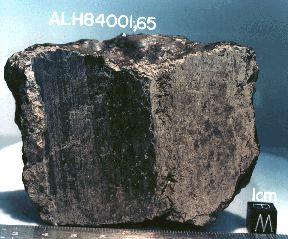The Mars Meteorite, ALH84001
Named for the year (1984) and the place it was found (Allan Hills region
in Antarctica), ALH84001 is perhaps the most famous meteorite in the
world. Why? In August 1996, researchers made the announcement of the
discovery of indications of past life in this meteorite from Mars.
We were not alone in the Universe!
The implications were exciting and thought provoking, and they remain so even though further investigation by other teams of scientists has cast serious doubts over these particular findings.
ALH84001 is not the only Martian Meteorite (there are 12 all together). But it is slightly different than the others.
First, all the other Martian meteorites are made of basalt, and are rather young (< 1.3 b.y.o) which lead to their connection to Mars. ALH84001 is not basalt, but almost pure pyroxene, which solidified during the original formation of the planet (making it 4.5 b.y.o.). This means it is the only Mars meteorite that gives us a glimpse at very early Martian conditions.
Second, ALH84001 shows visible and abundant veins of carbonate minerals running through it. These minerals, such as calcite, appear to have precipitated within the rock from water present within it, and this precipitation occured long ago.
Since it had apparently lived in a warm water climate, and since it dates back to the very earliest periods when we feel Mars might have had a warmer, wetter, denser atmosphere conducive to life, it was immediately searched for evidence of life. Indeed, it is within the original fractures and pore spaces and where secondary mineral formation is seen where the researchers find possible evidence of biogenic activity. The two scientists on the study, David McKay and Everett Gibson, were from the NASA's Johnson Space Flight Center in Houston, TX.
